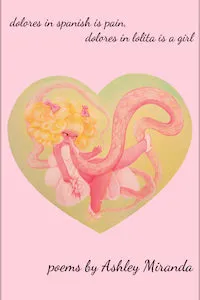
What Are Chapbooks? and Why You Should Read Them
This content contains affiliate links. When you buy through these links, we may earn an affiliate commission.
In a nutshell, chapbooks are teeny books. Merriam-Webster defines them as a small book containing ballads, poems, tales, or tracts. They are collections of poems, stories, or an experimental mix of both. Chapbooks usually hover in the range of 20–40 pages and are more affordable purchases to their novel counterparts. In a world where there’s a lot of talk of dwindling attention spans and having little time to read (sigh), chapbooks are a great way to soak up great writing—writing that may not quite fit anywhere else—and be able to finish in one sitting. But of course, there’s more to chapbooks than simply being short in length. Chapbooks are a way to make a point. They are an art form as much as a literary form, used for both revolution, protest, and exploration. Many presses take great care in the final presentation of this often-overlooked work.
 The Passion of Woo & Isolde by Jennifer Tseng was winner of the 11th annual contest, which was judged by Amelia Gray, and published in August 2017. Tseng’s chapbook consists of 24 pieces of flash fiction, ranging from a fairytale-like story of a mouse and a lion coming to an agreement, to a story of two newlyweds who make love without understanding one another, because they speak different languages. It’s a collection about immigration and exile, and despite its short length, it is absolutely haunting in its scope.
The Passion of Woo & Isolde went onto win numerous accolades, such as being a finalist for the Best Small Fictions of 2018, a finalist for the 2018 CLMP Firecracker Award in Fiction, and won the 2018 Eric Hoffer Award for Best Chapbook.
The Passion of Woo & Isolde by Jennifer Tseng was winner of the 11th annual contest, which was judged by Amelia Gray, and published in August 2017. Tseng’s chapbook consists of 24 pieces of flash fiction, ranging from a fairytale-like story of a mouse and a lion coming to an agreement, to a story of two newlyweds who make love without understanding one another, because they speak different languages. It’s a collection about immigration and exile, and despite its short length, it is absolutely haunting in its scope.
The Passion of Woo & Isolde went onto win numerous accolades, such as being a finalist for the Best Small Fictions of 2018, a finalist for the 2018 CLMP Firecracker Award in Fiction, and won the 2018 Eric Hoffer Award for Best Chapbook.
 And let’s not forget poetry! Glass Poetry Press, Haymarket Books, Black Lawrence Press, are just a few examples of presses who publish chapbooks of both emerging and established poets. In September 2018, Haymarket Books published the chapbook On My Way to Liberation by H. Melt. It is a chapbook that centers on a gender nonconforming body walking through the streets of Chicago. I was in the same MFA program as H. Melt at the School of the Art Institute of Chicago. They are a fierce, essential presence in both the trans and poetry communities. This is an example of a chapbook writing toward revolution, liberation, and building a better future.
And let’s not forget poetry! Glass Poetry Press, Haymarket Books, Black Lawrence Press, are just a few examples of presses who publish chapbooks of both emerging and established poets. In September 2018, Haymarket Books published the chapbook On My Way to Liberation by H. Melt. It is a chapbook that centers on a gender nonconforming body walking through the streets of Chicago. I was in the same MFA program as H. Melt at the School of the Art Institute of Chicago. They are a fierce, essential presence in both the trans and poetry communities. This is an example of a chapbook writing toward revolution, liberation, and building a better future.
 Glass Poetry Press also publishes beautiful chapbooks, including dolores in spanish is pain, dolores in lolita is a girl by Ashley Miranda, who is also a former classmate of mine from SAIC (I know, this is starting to come across as a love letter to my classmates, but my knowledge and respect of chapbooks was born from these great writers!). This chapbook centers on the violence against women and girls, and it is a deeply important, relevant work. Miranda is a poet who works in many forms and structures, and you can get a sense of her work by reading a sample poem from the chapbook.
Glass Poetry Press also publishes beautiful chapbooks, including dolores in spanish is pain, dolores in lolita is a girl by Ashley Miranda, who is also a former classmate of mine from SAIC (I know, this is starting to come across as a love letter to my classmates, but my knowledge and respect of chapbooks was born from these great writers!). This chapbook centers on the violence against women and girls, and it is a deeply important, relevant work. Miranda is a poet who works in many forms and structures, and you can get a sense of her work by reading a sample poem from the chapbook.
Fiction and Hybrid Chapbooks
Rose Metal Press is an example of a press who champions short, hybrid works. I interned there for a short period a few years ago. There, I was able to see how a chapbook came together, and I saw the love its founders devoted toward this literary form. Kathleen Rooney and Abigail Beckel founded the press in 2006. Since then, they have published beautiful hybrid and experimental works of fiction, non-fiction, and poetry. Additionally, Rose Metal Press hosts an annual Short Short Chapbook Contest. The Passion of Woo & Isolde by Jennifer Tseng was winner of the 11th annual contest, which was judged by Amelia Gray, and published in August 2017. Tseng’s chapbook consists of 24 pieces of flash fiction, ranging from a fairytale-like story of a mouse and a lion coming to an agreement, to a story of two newlyweds who make love without understanding one another, because they speak different languages. It’s a collection about immigration and exile, and despite its short length, it is absolutely haunting in its scope.
The Passion of Woo & Isolde went onto win numerous accolades, such as being a finalist for the Best Small Fictions of 2018, a finalist for the 2018 CLMP Firecracker Award in Fiction, and won the 2018 Eric Hoffer Award for Best Chapbook.
The Passion of Woo & Isolde by Jennifer Tseng was winner of the 11th annual contest, which was judged by Amelia Gray, and published in August 2017. Tseng’s chapbook consists of 24 pieces of flash fiction, ranging from a fairytale-like story of a mouse and a lion coming to an agreement, to a story of two newlyweds who make love without understanding one another, because they speak different languages. It’s a collection about immigration and exile, and despite its short length, it is absolutely haunting in its scope.
The Passion of Woo & Isolde went onto win numerous accolades, such as being a finalist for the Best Small Fictions of 2018, a finalist for the 2018 CLMP Firecracker Award in Fiction, and won the 2018 Eric Hoffer Award for Best Chapbook.
Poetry Chapbooks
 And let’s not forget poetry! Glass Poetry Press, Haymarket Books, Black Lawrence Press, are just a few examples of presses who publish chapbooks of both emerging and established poets. In September 2018, Haymarket Books published the chapbook On My Way to Liberation by H. Melt. It is a chapbook that centers on a gender nonconforming body walking through the streets of Chicago. I was in the same MFA program as H. Melt at the School of the Art Institute of Chicago. They are a fierce, essential presence in both the trans and poetry communities. This is an example of a chapbook writing toward revolution, liberation, and building a better future.
And let’s not forget poetry! Glass Poetry Press, Haymarket Books, Black Lawrence Press, are just a few examples of presses who publish chapbooks of both emerging and established poets. In September 2018, Haymarket Books published the chapbook On My Way to Liberation by H. Melt. It is a chapbook that centers on a gender nonconforming body walking through the streets of Chicago. I was in the same MFA program as H. Melt at the School of the Art Institute of Chicago. They are a fierce, essential presence in both the trans and poetry communities. This is an example of a chapbook writing toward revolution, liberation, and building a better future.
 Glass Poetry Press also publishes beautiful chapbooks, including dolores in spanish is pain, dolores in lolita is a girl by Ashley Miranda, who is also a former classmate of mine from SAIC (I know, this is starting to come across as a love letter to my classmates, but my knowledge and respect of chapbooks was born from these great writers!). This chapbook centers on the violence against women and girls, and it is a deeply important, relevant work. Miranda is a poet who works in many forms and structures, and you can get a sense of her work by reading a sample poem from the chapbook.
Glass Poetry Press also publishes beautiful chapbooks, including dolores in spanish is pain, dolores in lolita is a girl by Ashley Miranda, who is also a former classmate of mine from SAIC (I know, this is starting to come across as a love letter to my classmates, but my knowledge and respect of chapbooks was born from these great writers!). This chapbook centers on the violence against women and girls, and it is a deeply important, relevant work. Miranda is a poet who works in many forms and structures, and you can get a sense of her work by reading a sample poem from the chapbook.









